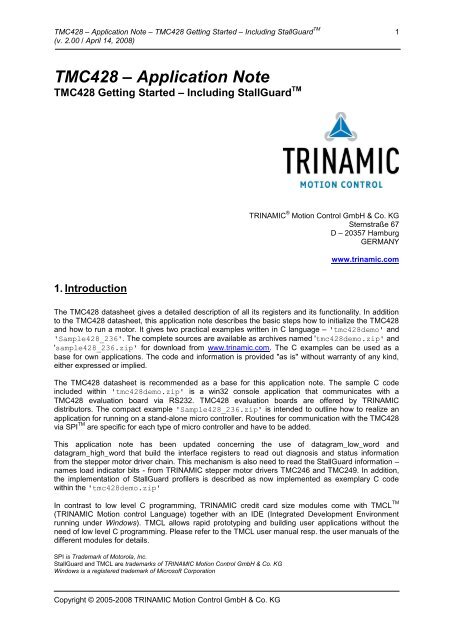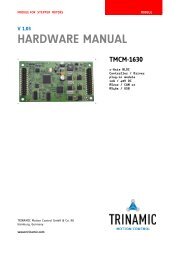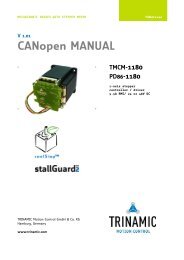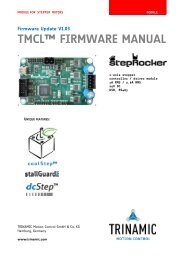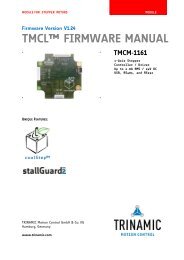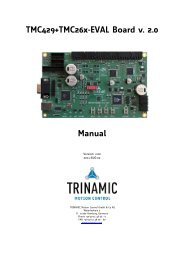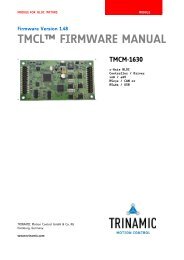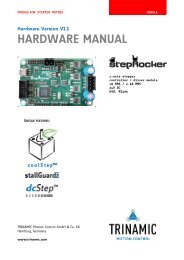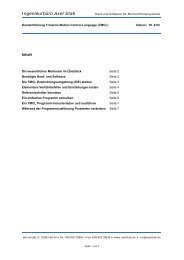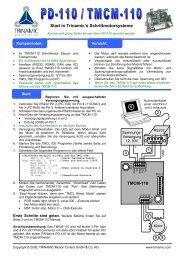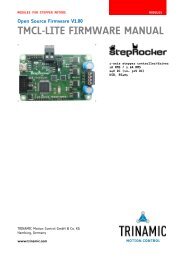TMC428 – Application Note - Trinamic
TMC428 – Application Note - Trinamic
TMC428 – Application Note - Trinamic
Create successful ePaper yourself
Turn your PDF publications into a flip-book with our unique Google optimized e-Paper software.
<strong>TMC428</strong> <strong>–</strong> <strong>Application</strong> <strong>Note</strong> <strong>–</strong> <strong>TMC428</strong> Getting Started <strong>–</strong> Including StallGuard TM 1<br />
(v. 2.00 / April 14, 2008)<br />
<strong>TMC428</strong> <strong>–</strong> <strong>Application</strong> <strong>Note</strong><br />
<strong>TMC428</strong> Getting Started <strong>–</strong> Including StallGuard TM<br />
1. Introduction<br />
Copyright © 2005-2008 TRINAMIC Motion Control GmbH & Co. KG<br />
TRINAMIC ® Motion Control GmbH & Co. KG<br />
Sternstraße 67<br />
D <strong>–</strong> 20357 Hamburg<br />
GERMANY<br />
www.trinamic.com<br />
The <strong>TMC428</strong> datasheet gives a detailed description of all its registers and its functionality. In addition<br />
to the <strong>TMC428</strong> datasheet, this application note describes the basic steps how to initialize the <strong>TMC428</strong><br />
and how to run a motor. It gives two practical examples written in C language <strong>–</strong> 'tmc428demo' and<br />
'Sample428_236'. The complete sources are available as archives named 'tmc428demo.zip' and<br />
'sample428_236.zip' for download from www.trinamic.com. The C examples can be used as a<br />
base for own applications. The code and information is provided "as is" without warranty of any kind,<br />
either expressed or implied.<br />
The <strong>TMC428</strong> datasheet is recommended as a base for this application note. The sample C code<br />
included within 'tmc428demo.zip' is a win32 console application that communicates with a<br />
<strong>TMC428</strong> evaluation board via RS232. <strong>TMC428</strong> evaluation boards are offered by TRINAMIC<br />
distributors. The compact example 'Sample428_236.zip' is intended to outline how to realize an<br />
application for running on a stand-alone micro controller. Routines for communication with the <strong>TMC428</strong><br />
via SPI TM are specific for each type of micro controller and have to be added.<br />
This application note has been updated concerning the use of datagram_low_word and<br />
datagram_high_word that build the interface registers to read out diagnosis and status information<br />
from the stepper motor driver chain. This mechanism is also need to read the StallGuard information <strong>–</strong><br />
names load indicator bits - from TRINAMIC stepper motor drivers TMC246 and TMC249. In addition,<br />
the implementation of StallGuard profilers is described as now implemented as exemplary C code<br />
within the 'tmc428demo.zip'<br />
In contrast to low level C programming, TRINAMIC credit card size modules come with TMCL TM<br />
(TRINAMIC Motion control Language) together with an IDE (Integrated Development Environment<br />
running under Windows). TMCL allows rapid prototyping and building user applications without the<br />
need of low level C programming. Please refer to the TMCL user manual resp. the user manuals of the<br />
different modules for details.<br />
SPI is Trademark of Motorola, Inc.<br />
StallGuard and TMCL are trademarks of TRINAMIC Motion Control GmbH & Co. KG<br />
Windows is a registered trademark of Microsoft Corporation
<strong>TMC428</strong> <strong>–</strong> <strong>Application</strong> <strong>Note</strong> <strong>–</strong> <strong>TMC428</strong> Getting Started <strong>–</strong> Including StallGuard TM 2<br />
(v. 2.00 / April 14, 2008)<br />
Table of Contents<br />
1. Introduction ....................................................................................................................................... 1<br />
2. Initialization of the <strong>TMC428</strong> .............................................................................................................. 3<br />
2.1 <strong>TMC428</strong> Configuration RAM ..................................................................................................... 3<br />
2.2 Stepper Motor Global Parameter Register (JDX=%1111) ........................................................ 5<br />
2.3 Parameterizing Individual Stepper Motors ................................................................................ 6<br />
2.2.1 Velocity R[Hz] and Acceleration R[Hz/s] ......................................................................... 6<br />
2.2.2 Set the Reference Switch Configuration and the Ramp Mode .......................................... 8<br />
2.2.3 Set the Automatic Current Scaling [optional] ..................................................................... 8<br />
2.4 Running a Motor ........................................................................................................................ 8<br />
2.5 Communication Outline of tmc428demo and Sample428_236 ................................................ 9<br />
3. Reading Driver Chain Status Bits with <strong>TMC428</strong> ............................................................................. 10<br />
3.1 How to Get the Driver Chain Status Information <strong>–</strong> Code Example ......................................... 11<br />
3.2 How to Get the Status Bits of TMC246 / TMC249 <strong>–</strong> Code Example ....................................... 12<br />
3.3 How to Get the StallGuard Load Indicator (LD) Bits of TMC246 / TMC249 ............................ 12<br />
4. StallGuard Profiler .......................................................................................................................... 13<br />
4.1 StallGuard Demo <strong>–</strong> Source Code Example............................................................................. 13<br />
4.2 StallGuard Profiler <strong>–</strong> Source Code Example ........................................................................... 14<br />
4.3 StallGuard Profiler for continuous motion (VELOCITY MODE) .............................................. 14<br />
4.4 StallGuard Profiler for limited motion range (RAMP_MODE) ................................................. 14<br />
4.5 StallGuard <strong>–</strong> General Constrains ............................................................................................ 15<br />
4.6 How to Compare Different Motors Concerning StallGuard Qualification ................................ 16<br />
5. Overview of 'tmc428demo' ............................................................................................................. 17<br />
6. Overview of 'Sample428_236' ........................................................................................................ 17<br />
7. Literature & Links ........................................................................................................................... 18<br />
8. Revision History .............................................................................................................................. 18<br />
Table of Contents<br />
Figure 1 : SPI Chain Outline <strong>–</strong> Serial Transmitted Control Bits vs. Parallel Control Signals ................... 4<br />
Figure 2 : Stepper Motor Global Parameter Register Setting Example ................................................... 5<br />
Figure 3 : REF_CONF & RAMP_MODE Setting for Stepper Motor # 0 (smda = %00) ........................... 7<br />
Figure 4 : Automatic Current Scaling for a Stepper Motor ....................................................................... 8<br />
Figure 5 : Communication Outline for tmc428demo ................................................................................ 9<br />
Figure 6 : Example of status bit mapping for a chain of three TMC246 or TMC249 ............................. 10<br />
Figure 7 : StallGuard profiling (left continuous motion / right motion within limited range) .................... 14<br />
Figure 8 : Outline of a typical StallGuard Profile .................................................................................... 15<br />
Copyright © 2005-2008 TRINAMIC Motion Control GmbH & Co. KG
<strong>TMC428</strong> <strong>–</strong> <strong>Application</strong> <strong>Note</strong> <strong>–</strong> <strong>TMC428</strong> Getting Started <strong>–</strong> Including StallGuard TM 3<br />
(v. 2.00 / April 14, 2008)<br />
2. Initialization of the <strong>TMC428</strong><br />
On first sight, the sample C code included within the ZIP archive 'tmc428demo.zip' might give the<br />
impression that the initialization of the <strong>TMC428</strong> is a complicated task due to a couple of different<br />
routines used. The intent of this sample C code and its different routines is to demonstrate how to<br />
access the registers of the <strong>TMC428</strong>. All together, these routines just perform a sequence of SPI<br />
datagrams that perform the initialization of the <strong>TMC428</strong>. So, for those who are familiar with the<br />
<strong>TMC428</strong> and its SPI datagrams, the program structure might become more compact and the<br />
initialization code might look like<br />
for (i=0; i
<strong>TMC428</strong> <strong>–</strong> <strong>Application</strong> <strong>Note</strong> <strong>–</strong> <strong>TMC428</strong> Getting Started <strong>–</strong> Including StallGuard TM 4<br />
(v. 2.00 / April 14, 2008)<br />
For this sample configuration, the fast decay control bits of <strong>TMC428</strong> are mapped as fixed Zero for the<br />
driver #1, fixed One for the driver #2 of the chain. For driver # 3 the FD_A is mapped to MDA and<br />
FD_B is mapped to MDB. Please refer the TRINAMIC stepper motor driver datasheets (TMC236 /<br />
TMC239 / TMC246 / TMC249) concerning the mixed decay feature. In plain text, it is<br />
Zero, A_5, A_4, A_3, A_2, PH_A, Zero, B_5, B_4, B_3, B_2, PH_B, One, A_5, A_4, A_3,<br />
A_2, PH_A, One, B_5, B_4, B_3, B_2, PH_B, FD_A, A_5, A_4, A_3, A_2, PH_A FD_B, B_5,<br />
B_4, B_3, B_2, PH_B, One, One, One, One, One, One, One, One, One, One, One, One,<br />
One, One, One, One, One, One, One, One, One, One, One, One, One, One, One, One,<br />
0, 2, 3, 5, 6, 8, 9, 11, 12, 14, 16, 17, 19, 20, 22, 23,<br />
24, 26, 27, 29, 30, 32, 33, 34, 36, 37, 38, 39, 41, 42, 43, 44,<br />
45, 46, 47, 48, 49, 50, 51, 52, 53, 54, 55, 56, 56, 57, 58, 59,<br />
59, 60, 60, 61, 61, 62, 62, 62, 63, 63, 63, 63, 63, 63, 63, 63<br />
Please keep in mind that the DAC MSBs of the <strong>TMC428</strong> are DAC_A_5 resp. DAC_B_5, where the<br />
DAC MSBs of the TMC236 / TMC239 / TMC246 / TMC249 drivers are CA3 resp. CB3. So, DAC_A_5<br />
is mapped to CB3 resp. DAC_B_5 is mapped to CB3, and the other DAC bits are mapped accordingly.<br />
Once initialized, the configuration of the stepper motor driver chain is left unchanged in most cases<br />
during normal operation. In some cases, the fast decay control has to be changed. Please take into<br />
account that a write access to a RAM always overwrites a pair of <strong>TMC428</strong> RAM values. A read access<br />
to the RAM always reads out a pair of values. Combining RAM read and RAM write allows the<br />
modification of a single value.<br />
Use of the sensorless stall detection StallGuard (TMC246 / TMC249) requires the mixed decay feature<br />
to be switched off. At high speed, stepper motors might run better when the fast decay feature is<br />
permanently switched on. Some motors run best when mixed decay is switched on only during phases<br />
of decreasing current. The configuration can be modified also during operation by re-programming the<br />
stepper motor driver chain configuration.<br />
The quarter sine wave look-up table RAM area is left unchanged for almost any application after it has<br />
been initialized. Changes might be wanted for fine tuning of micro stepping or for temporary changing<br />
from micro stepping to full stepping at high speed or to use a trapezoidal current shape that is more<br />
compatible with StallGuard than full stepping. Sine wave micro stepping is the best choise for most<br />
applications. Additionally, one has to take into account that changes of the quarter sine wave look-up<br />
table commonly apply to all stepper motors.<br />
SDI_S<br />
SCK_S<br />
SDO_S<br />
nSCS_S<br />
CSN<br />
SCK<br />
SDI<br />
shift register<br />
parallel register<br />
0 1 2 3 4 5 6 7 8 9 10 11<br />
PHB<br />
CB0<br />
CB1<br />
CB2<br />
CB3<br />
MDB<br />
PHA<br />
CA0<br />
CA1<br />
CA2<br />
CA3<br />
MDA<br />
control signals<br />
Driver # 3<br />
TMC236 / TMC239 / TMC246 / TMC249<br />
Copyright © 2005-2008 TRINAMIC Motion Control GmbH & Co. KG<br />
SDO<br />
CSN<br />
SCK<br />
SDI<br />
shift register<br />
parallel register<br />
0 1 2 3 4 5 6 7 8 9 10 11<br />
PHB<br />
CB0<br />
CB1<br />
CB2<br />
CB3<br />
MDB<br />
PHA<br />
CA0<br />
CA1<br />
CA2<br />
CA3<br />
MDA<br />
control signals<br />
Driver # 2<br />
TMC236 / TMC239 / TMC246 / TMC249<br />
SDO<br />
CSN<br />
SCK<br />
SDI<br />
shift register<br />
parallel register<br />
0 1 2 3 4 5 6 7 8 9 10 11<br />
PHB<br />
CB0<br />
CB1<br />
CB2<br />
CB3<br />
MDB<br />
PHA<br />
CA0<br />
CA1<br />
CA2<br />
CA3<br />
MDA<br />
control signals<br />
Driver # 1<br />
TMC236 / TMC239 / TMC246 / TMC249<br />
Figure 1 : SPI Chain Outline <strong>–</strong> Serial Transmitted Control Bits vs. Parallel Control Signals<br />
All SPI datagram bits are shifted through the driver chain (Figure 1) with the SPI clock SCK_C. The<br />
actual content of the shift register chain is loaded into parallel buffer registers with the rising edge of<br />
the SPI enable signal nSCS_S. A set next motor bit forces the <strong>TMC428</strong> to select internally the control<br />
bits for the next motor. The next motor bit is not transmitted via the SPI driver chain. The different<br />
drivers are addressed by their position within the chain.<br />
SDO
<strong>TMC428</strong> <strong>–</strong> <strong>Application</strong> <strong>Note</strong> <strong>–</strong> <strong>TMC428</strong> Getting Started <strong>–</strong> Including StallGuard TM 5<br />
(v. 2.00 / April 14, 2008)<br />
2.2 Stepper Motor Global Parameter Register (JDX=%1111)<br />
The stepper motor global parameter register holds different flags (mot1r, refmux) to configure the<br />
references switches (REF1, REF2, REF3), the SPI interface update behavior (cont_update), speed<br />
(clk2_div), chip select (cs_ComInd), the polarities of different control bits of the SPI datagrams<br />
(DAC_AB, FD_AB, PH_AB) and the polarities of SPI control signals (SCK_S, nSCS_S) , and the<br />
number (LSMD) of stepper motor drivers within the chain. Please refer to the <strong>TMC428</strong> data sheet<br />
concerning functionalities of the flags. Figure 2 outlines an SPI datagram 0x7E010F02 to initialize the<br />
stepper motor global parameter register with LSMD=2 for 3 stepper motor drivers.<br />
3<br />
1<br />
RRS<br />
3<br />
0<br />
2<br />
9<br />
2<br />
8<br />
2<br />
7<br />
ADDRESS<br />
2<br />
6<br />
2<br />
5<br />
0 1 1 1 1 1 1<br />
2<br />
4<br />
RW<br />
2<br />
3<br />
Stepper Motor Global Parameter Register JDX=%1111<br />
2<br />
2<br />
2<br />
1<br />
mot1r<br />
Copyright © 2005-2008 TRINAMIC Motion Control GmbH & Co. KG<br />
2<br />
0<br />
refmux<br />
1<br />
9<br />
1<br />
8<br />
1<br />
7<br />
1<br />
6<br />
cont_update<br />
1<br />
5<br />
1<br />
4<br />
1<br />
3<br />
1<br />
2<br />
1<br />
1<br />
DATA<br />
clk2_div<br />
1<br />
0<br />
9 8 7 6 5 4 3 2 1 0<br />
cs_ComInd<br />
polarities<br />
0 1 1 1 1 1 1 0 0 0 0 0 0 0 0 1 0 0 0 0 0 1 1 1 0 0 0 0 0 0 1 0<br />
7 E 0 1 0 7 0 2<br />
Figure 2 : Stepper Motor Global Parameter Register Setting Example<br />
DAC_AB<br />
FD_AB<br />
PH_AB<br />
SCK_S<br />
nSCS_S<br />
LSMD
<strong>TMC428</strong> <strong>–</strong> <strong>Application</strong> <strong>Note</strong> <strong>–</strong> <strong>TMC428</strong> Getting Started <strong>–</strong> Including StallGuard TM 6<br />
(v. 2.00 / April 14, 2008)<br />
2.3 Parameterizing Individual Stepper Motors<br />
Each stepper motor has its associated set of registers for motion control. Before running a motor,<br />
some parameters have to be initialized once. For many applications, there is no need to re-program<br />
settings done once during initialization. Once initialized, the motion control becomes quite easy. For<br />
ramp_mode the micro controller just sends desired target positions and the <strong>TMC428</strong> autonomously<br />
takes care of positioning. For velocity_mode, the micro controller just sends the desired target velocity<br />
to the <strong>TMC428</strong> to run a stepper motor continuously.<br />
On first sight, the determination of the required parameters might look a little bit complicated but it is<br />
simple. These parameters allow the adjustment to a very wide range of applications. The motion<br />
control parameters are represented as integer resp. signed integer values within units that are specific<br />
for the <strong>TMC428</strong> depending on the clock frequency used for the <strong>TMC428</strong>.<br />
From the stepper motor application point of view, motion control parameters within units of full steps<br />
(FS) for position, full steps per second (FS/s) for velocity, and full steps per second square (FS/s^2) for<br />
acceleration are natural units for stepper motors. The formulas to calculate into these units are given<br />
within the <strong>TMC428</strong> data sheet section pulse_div & ramp_div & usrs (IDX=%1100)). A spread sheet<br />
named 'tmc428_frequencies.xls' that calculates between physical motion units (rad, rad/s, …)<br />
and stepper specific units (FS, FS/s, …) and a stand-alone program '<strong>TMC428</strong>Calc.exe' are<br />
available on www.trinamic.com<br />
2.2.1 Velocity R[Hz] and Acceleration R[Hz/s]<br />
The desired micro step frequency R[Hz] and the desired R[Hz] micro step acceleration depend on the<br />
application. Typical stepper motors can go up to full step frequencies of some thousand full steps per<br />
second. Without load, they can accelerate to those full step frequencies within a couple of full steps.<br />
2.2.1.1 Choosing Micro Step Resolution / Step Pulse Pre-Divider / Acceleration Pre-Divider<br />
First, one has to choose the micro step resolution. Following, the highest micro step resolution is<br />
chosen be setting usrs = 6. Then, the pulse pre-divider has to be determined. It allows to scale the<br />
step frequencies in a very wide range. Based on the formula R[Hz] = f_clk[Hz] * velocity / ( 2^pulse_div<br />
* 2048 * 32 ) given within the <strong>TMC428</strong> datasheet one can determine<br />
pulse_div := log( f_clk[Hz] * v_max / ( R[Hz] * 2048 * 32 ) ) / log(2)<br />
setting v_max = 2047 (resp. 2048 for simplified calculation) and R[Hz] to the maximum desired micro<br />
step frequency. The full step frequency can be calculated based on the formula RFS[Hz] = R[Hz] /<br />
2^usrs given within the <strong>TMC428</strong> data sheet. With this, the micro step frequency is R[Hz] = RFS[Hz] *<br />
2^usrs. The quotient of logarithms comes from the relation log2(x) = log(x) / log(2) to calculate the<br />
logarithm to the basis of two which is the number of bits need to represent x. The calculation result of<br />
pulse_div then has to be chosen close to the next integer value.<br />
After determination of pulse_div, the parameter ramp_div can be calculated. Based on the formula<br />
R[Hz/s] = f_clk[Hz] * f_clk[Hz] * a_max / ( 2^(pulse_div+ramp_div+29) ) given within the <strong>TMC428</strong><br />
datasheet one can determine<br />
ramp_div := log( f_clk[Hz] * f_clk[Hz] * a_max / ( R[Hz/s] * 2^(pulse_div+29) ) ) / log(2)<br />
setting a_max = 2047 (resp. 2048 for simplified calculation) and R[Hz/s] to the maximum desired<br />
micro step acceleration. The calculation result of ramp_div then has to be chosen close to the next<br />
integer value.<br />
Copyright © 2005-2008 TRINAMIC Motion Control GmbH & Co. KG
<strong>TMC428</strong> <strong>–</strong> <strong>Application</strong> <strong>Note</strong> <strong>–</strong> <strong>TMC428</strong> Getting Started <strong>–</strong> Including StallGuard TM 7<br />
(v. 2.00 / April 14, 2008)<br />
2.2.1.2 Choosing Step Velocities v_min and v_max and the Step Acceleration a_max<br />
The v_min parameter should be set to 1 (please refer the <strong>TMC428</strong> data sheet for details). The v_max<br />
parameter determines the maximum velocity and has to be set depending on the application. Once set,<br />
the a_max parameter can be left untouched for many applications. Change of the parameter a_max<br />
requires recalculation of p_mul and p_div.<br />
If the parameters pulse_div and ramp_div are equal, the parameter a_max can be set to any value<br />
within the range of 0 … 2047. If the parameters pulse_div and ramp_div differ, the limits<br />
a_max_lower_limit and a_max_upper_limit have to be checked (please refer to the TMC datasheet<br />
for details). The velocity does not change with a_max = 0.<br />
2.2.1.3 Calculate p_mul & p_div for a Chosen Set of Parameters<br />
Two parameters named p_mul and p_div have to be calculated for positioning in RAMP_MODE.<br />
These parameters depend on pulse_div, ramp_div, and a_max. So, they have to be determined for a<br />
set of pulse_div, ramp_div, a_max. The parameters p_mul and p_div have to be recalculated if one<br />
of the parameters pulse_div, ramp_div, a_max changes.<br />
An example for calculation of p_mul and p_div for the <strong>TMC428</strong> is given as a C program included<br />
within the <strong>TMC428</strong> datasheet. This C program source code can be copied directly out of the PDF<br />
document. Additionally, a spread sheet named tmc428_pmulpdiv.xls demonstrating the calculation<br />
of pmul and pdiv is available on www.trinamic.com for download.<br />
The principle of calculation of p_mul and p_div is simple: The routine CalcPMulPDiv(...) gets the<br />
parameters a_max, ramp_div, pulse_div, with a reduction factor p_reduction. With these parameters,<br />
a pmul is calculated for any allowed p_div ranging from 0 to 13. That p_div, that results in a valid<br />
pmul that is in the range of 0 to 127 (resp. p_mul that is in range 128 … 255) selects a valid pair of<br />
p_mul and p_div.<br />
3<br />
1<br />
RRS<br />
0<br />
3<br />
0<br />
2<br />
9<br />
2<br />
8<br />
2<br />
7<br />
ADDRESS<br />
2<br />
6<br />
2<br />
5<br />
smda 1 0 1 0<br />
2<br />
4<br />
RW<br />
2<br />
3<br />
Register ref_conf & rm IDX=%1010 (one for each motor)<br />
2<br />
2<br />
2<br />
1<br />
Copyright © 2005-2008 TRINAMIC Motion Control GmbH & Co. KG<br />
2<br />
0<br />
1<br />
9<br />
1<br />
8<br />
1<br />
7<br />
latched position<br />
(waiting)<br />
1<br />
6<br />
1<br />
5<br />
1<br />
4<br />
1<br />
3<br />
1<br />
2<br />
1<br />
1<br />
DATA<br />
1<br />
0<br />
9 8 7 6 5 4 3 2 1 0<br />
lp ref_conf rm<br />
0 0 0 1 0 1 0 0 0 0 0 0 0 0 0 0 0 0 0 0 0 0 1 1 0 0 0 0 0 0 0 0<br />
1 4 0 0 0 3 0 0<br />
Figure 3 : REF_CONF & RAMP_MODE Setting for Stepper Motor # 0 (smda = %00)<br />
REF_RnL<br />
SOFT_STOP<br />
DISABLE_STOP_R<br />
DISABLE_STOP_L
<strong>TMC428</strong> <strong>–</strong> <strong>Application</strong> <strong>Note</strong> <strong>–</strong> <strong>TMC428</strong> Getting Started <strong>–</strong> Including StallGuard TM 8<br />
(v. 2.00 / April 14, 2008)<br />
2.2.2 Set the Reference Switch Configuration and the Ramp Mode<br />
Both, the reference switch configuration and the ramp mode are configured by access to a single<br />
register. Normally, this kind of initialization is done once. The switch configuration ref_conf together<br />
with the ramp mode rm has to be chosen. Unused reference switch inputs REF1, REF2, REF3 should<br />
be pulled down to ground or disabled by setting ref_conf. Otherwise, the REF1, REEF2, REF3 inputs<br />
might detect a switch signal and stop a motor.<br />
2.2.3 Set the Automatic Current Scaling [optional]<br />
With the power-on reset settings, the full current is driven when the motor is at rest, during<br />
acceleration, and during motion. Automatic down scaling when the motor is at rest reduces power<br />
dissipation. This makes sense if the application allows lower holding torque for a motor at rest.<br />
For automatic current scaling, it is necessary to switch on the continuous_update, to force the<br />
<strong>TMC428</strong> to send the current scaling datagram, even if all motors are at rest. That does not cause the<br />
<strong>TMC428</strong> to sent datagrams to the stepper motor driver chain.<br />
2.4 Running a Motor<br />
With all these setting described before, one can simply run a stepper motor. In RAMP_MODE, one just<br />
has to write the desired target position into the register x_target of the associated motor. In<br />
VELOCITY_MODE, one just has to write the desired target velocity v_target of the associated motor.<br />
3<br />
1<br />
RRS<br />
3<br />
0<br />
2<br />
9<br />
2<br />
8<br />
2<br />
7<br />
ADDRESS<br />
2<br />
6<br />
2<br />
5<br />
Register is_agtat & is_aleat & is_v0 IDX=%1000 (one for each motor)<br />
2<br />
4<br />
RW<br />
2<br />
3<br />
2<br />
2<br />
2<br />
1<br />
Copyright © 2005-2008 TRINAMIC Motion Control GmbH & Co. KG<br />
2<br />
0<br />
1<br />
9<br />
1<br />
8<br />
1<br />
7<br />
1<br />
6<br />
1<br />
5<br />
1<br />
4<br />
1<br />
3<br />
1<br />
2<br />
1<br />
1<br />
DATA<br />
1<br />
0<br />
9 8 7 6 5 4 3 2 1 0<br />
smda 1 0 0 0 is_agtat is_aleat is_v0 a_threshold<br />
0 0 0 1 0 0 0 0 0 0 0 0 0 0 0 0 0 0 0 1 0 0 0 0 0 0 0 0 0 0 0 0<br />
1 0 0 0 1 0 0 0<br />
Figure 4 : Automatic Current Scaling for a Stepper Motor
<strong>TMC428</strong> <strong>–</strong> <strong>Application</strong> <strong>Note</strong> <strong>–</strong> <strong>TMC428</strong> Getting Started <strong>–</strong> Including StallGuard TM 9<br />
(v. 2.00 / April 14, 2008)<br />
2.5 Communication Outline of tmc428demo and Sample428_236<br />
The tmc428demo.exe is a win32 console application. Its communication takes place over a RS232<br />
interface byte by byte. The windows based RS232 communication is used to perform a 32 bit wide SPI<br />
communication with the <strong>TMC428</strong> on a evaluation kit.<br />
For an embedded application running stand alone on a µC, the user just has to write an SPI routine for<br />
the µC used for communication between µC an <strong>TMC428</strong>. For the code example Sample428_236, the<br />
SPI routine spi428_uc() for communication with the <strong>TMC428</strong> is named Send428(). This has to be<br />
completed for a given type of micro controller.<br />
The communication is outlined by Figure 5 on page 9.<br />
Windows-PC / µC Eval Board Configuration<br />
Windows-PC<br />
<strong>TMC428</strong>DEMO<br />
main()<br />
tmc428spi()<br />
spi4win()<br />
rs232win32()<br />
RS232<br />
µC + <strong>TMC428</strong><br />
(e.g. evaluation board)<br />
RS232<br />
rs232uc()<br />
spi428_uc()*<br />
<strong>TMC428</strong><br />
*spi428_uc() to be implemented by user<br />
(either software SPI or hardware SPI)<br />
Figure 5 : Communication Outline for tmc428demo<br />
Copyright © 2005-2008 TRINAMIC Motion Control GmbH & Co. KG<br />
Stand-Alone µC-<strong>TMC428</strong><br />
Configuration<br />
Embedded System<br />
( µC + <strong>TMC428</strong> )<br />
<strong>TMC428</strong>DEMO<br />
main()<br />
tmc428spi()<br />
spi428_uc()*<br />
<strong>TMC428</strong>
<strong>TMC428</strong> <strong>–</strong> <strong>Application</strong> <strong>Note</strong> <strong>–</strong> <strong>TMC428</strong> Getting Started <strong>–</strong> Including StallGuard TM 10<br />
(v. 2.00 / April 14, 2008)<br />
3. Reading Driver Chain Status Bits with <strong>TMC428</strong><br />
Beyond the basic initializations required to run stepper motors with the <strong>TMC428</strong>, the read out of status<br />
bits from the stepper motor driver chain is important for diagnosis and to use the sensorless stall<br />
detection StallGuard that is integrated within the TMC246 and TMC249 stepper motor drivers.<br />
The status bits of TMC246 and TMC249 are: three load indicator bits (LD2, LD1, LD0), over<br />
temperature (OT), over temperature pre-warning (OTPW), under voltage (UV), over current high side<br />
(OCHS), open load bridge B (OLB), open load bridge A (OLA), over current bridge B low side (OCB),<br />
over current bridge A low side (OCA). For the TMC236 and TMC239, the load indicator bits (LD2, LD1,<br />
LD0) are permanent „0‟. The status bits are shifted through the driver chain. The SDO output of the last<br />
stepper motor driver of the SPI chain has to be connected with the SDI_S of the <strong>TMC428</strong>.<br />
To get the status bits from the stepper motor driver chain, fetching of them has to be initialized first by<br />
a write access to either datagram_high_word or datagram_low_word. Then, with the next SPI<br />
datagram the <strong>TMC428</strong> sends to the stepper motor driver chain, it gets associated stepper motor status<br />
bits and holds them within the registers datagram_high_word and datagram_low_word.<br />
Due to the fact, that the <strong>TMC428</strong> autonomously updates the stepper motor driver chain, status<br />
information is required that indicates that datagram_high_word and datagram_low_word have been<br />
updated. The status bit CDGW (Cover DataGram Waiting) provides this status information. Its name<br />
CDGW sometimes causes a little confusion. In principle, the CDGW should be named like<br />
CDGW_or_WFDHWDLW (Cover DataGram Waiting / Waiting for Datagram High Word Datagram<br />
Low Word). The cover datagram mechanism <strong>–</strong> to send an arbitrary datagram from the µC to the<br />
stepper motor driver chain <strong>–</strong> and the datagram high word and datagram low word both use this single<br />
status bit named CDGW. The CDGR status bit is part of each SPI datagram sent from <strong>TMC428</strong> to µC.<br />
To get the driver chain status bits, the following actions have to be done:<br />
1. Initialize the fetching mechanism by a write to datagram_high_word or datagram_low_word<br />
2. Send datagramms to the <strong>TMC428</strong> (e.g. read out some <strong>TMC428</strong> registers)<br />
3. Extract the CDGW from datagramms received from the <strong>TMC428</strong> to read the CDGW<br />
4. Read the CDGW until it becomes „0‟<br />
5. If the CDGW is „0‟ read out the datagram_high_word and datagram_low_word<br />
6. Extract the status bits of interest from datagram_high_word and datagram_low_word<br />
23 22 21 20 19 18 17 16 15 14 13 12 11 10 9 8 7 6 5 4 3 2 1 0<br />
LD2 LD1 LD0 1 OT OTPW UV OCHS OLB OLA OCB OCA<br />
datagram_high_word<br />
datagram_low_word<br />
Copyright © 2005-2008 TRINAMIC Motion Control GmbH & Co. KG<br />
LD2 LD1 LD0 1 OT OTPW UV OCHS OLB OLA OCB OCA<br />
last TMC246 driver of the chain (stepper motor #1)<br />
23 22 21 20 19 18 17 16 15 14 13 12 11 10 9 8 7 6 5 4 3 2 1 0<br />
second TMC246 driver of the chain (stepper motor # 2)<br />
LD2 LD1 LD0 1 OT OTPW UV OCHS OLB OLA OCB OCA<br />
first TMC246 driver of the chain (stepper motor # 3)<br />
Figure 6: Example of status bit mapping for a chain of three TMC246 or TMC249<br />
SDI_S
<strong>TMC428</strong> <strong>–</strong> <strong>Application</strong> <strong>Note</strong> <strong>–</strong> <strong>TMC428</strong> Getting Started <strong>–</strong> Including StallGuard TM 11<br />
(v. 2.00 / April 14, 2008)<br />
3.1 How to Get the Driver Chain Status Information <strong>–</strong> Code Example<br />
The following C code example (part of tmc428demo.zip) outlines how to get the raw status bits from a<br />
SPI stepper motor driver chain into the <strong>TMC428</strong> registers datagram_high_word and<br />
datagram_low_word.<br />
void tmc428_get_datagram_words( long int *datagram_low_word, long int *datagram_high_word )<br />
{<br />
long int spi, spo;<br />
}<br />
// write datagram_low_word (or high_word) for initialization, sets CDGW to '1'<br />
spi = spi428glue( 0, 0x3, JDX_DATAGRAMM_LOW, WRITE, 0);<br />
spo = tmc428spi( spi );<br />
// wait until CDGW becomes '0'<br />
do<br />
{<br />
Sleep(1); // (wait 1ms, allows the operating system to focus on other tasks)<br />
spi = spi428glue( 0, 0x3, JDX_DATAGRAMM_LOW, READ, 0);<br />
spo = tmc428spi( spi );<br />
} while (!(0x40000000 & (~spo))); // mask CDGW<br />
spi = spi428glue( 0, 0x3, JDX_DATAGRAMM_LOW, READ, 0);<br />
spo = tmc428spi( spi );<br />
*datagram_low_word = 0x00FFFFFF & spo;<br />
spi = spi428glue( 0, 0x3, JDX_DATAGRAMM_HIGH, READ, 0);<br />
spo = tmc428spi( spi );<br />
*datagram_high_word = 0x00FFFFFF & spo;<br />
Copyright © 2005-2008 TRINAMIC Motion Control GmbH & Co. KG
<strong>TMC428</strong> <strong>–</strong> <strong>Application</strong> <strong>Note</strong> <strong>–</strong> <strong>TMC428</strong> Getting Started <strong>–</strong> Including StallGuard TM 12<br />
(v. 2.00 / April 14, 2008)<br />
3.2 How to Get the Status Bits of TMC246 / TMC249 <strong>–</strong> Code Example<br />
The following C code example (part of tmc428demo.zip) outlines how to get the raw status bits of each<br />
TMC246 or TMC249 driver. This is just a little data shifting.<br />
void tmc428_get_tmc24x_status_bits( int *sm0_status, int *sm1_status, int *sm2_status )<br />
{<br />
long int datagram_low_word, datagram_high_word;<br />
int lsmd;<br />
}<br />
// this routine assumes a chain of up to three TMC246 / TMC249 drivers<br />
// pls. refer <strong>TMC428</strong> datasheet v. 2.02 / April 26, 2007 or newer<br />
tmc428_get_datagram_words( &datagram_low_word, &datagram_high_word );<br />
// 1st, determine the number of TMC246 resp. TMC249 stepper motor drivers<br />
tmc428_get_lsmd( &lsmd );<br />
switch (((char)lsmd))<br />
{<br />
case 3 : ; // <strong>TMC428</strong> interprets LSMD=3 as LSMD = 2 // NO "break;"<br />
case 2 : *sm0_status = 0x0fff & ( datagram_high_word >> 0 ); // motor #1<br />
*sm1_status = 0x0fff & ( datagram_low_word >> 12 ); // motor #2<br />
*sm2_status = 0x0fff & ( datagram_low_word >> 0 ); // motor #3<br />
break;<br />
}<br />
case 1 : *sm0_status = 0x0fff & ( datagram_low_word >> 12 ); // motor #1<br />
*sm1_status = 0x0fff & ( datagram_low_word >> 0 ); // motor #2<br />
*sm2_status = 0x0000; // motor #3<br />
break;<br />
case 0 : *sm0_status = 0x0fff & ( datagram_low_word >> 0 ); // motor #1<br />
*sm1_status = 0x0000; // motor #2<br />
*sm2_status = 0x0000; // motor #3<br />
break;<br />
3.3 How to Get the StallGuard Load Indicator (LD) Bits of TMC246 / TMC249<br />
The following C code example (part of tmc428demo.zip) outlines how to get the load indicator bits of<br />
each TMC246 or TMC249 driver to be used for StallGuard.<br />
void tmc428_get_tmc24x_stallguard_bits( int sm, int *ld )<br />
{<br />
int sm0_status, sm1_status, sm2_status;<br />
}<br />
tmc428_get_tmc24x_status_bits( &sm0_status, &sm1_status, &sm2_status );<br />
switch (((char)sm))<br />
{<br />
case 0 : *ld = 0x7 & ( sm0_status >> 9 ); break;<br />
case 1 : *ld = 0x7 & ( sm1_status >> 9 ); break;<br />
case 2 : *ld = 0x7 & ( sm2_status >> 9 ); break;<br />
}<br />
At a given speed, a stall of the motor is detected by comparing load indicator bits (LD2, LD1, LD0)<br />
forming a three bit vector LD with a threshold. The threshold has to be determined for a given stepper<br />
motor within its application. The StallGuard signal (load indicator bits) depends on the speed of the<br />
motors.<br />
Copyright © 2005-2008 TRINAMIC Motion Control GmbH & Co. KG
<strong>TMC428</strong> <strong>–</strong> <strong>Application</strong> <strong>Note</strong> <strong>–</strong> <strong>TMC428</strong> Getting Started <strong>–</strong> Including StallGuard TM 13<br />
(v. 2.00 / April 14, 2008)<br />
4. StallGuard Profiler<br />
StallGuard is primarily intended for noiseless reference search with a mechanical reference position.<br />
How well StallGuard works primarily depends on three constrains from the stepper motor and its<br />
application:<br />
efficiency of a stepper motor in terms of mechanical power vs. power dissipation<br />
difference in mechanical load between free running and stall on barrier<br />
velocity of the stepper motor<br />
If a given stepper motor and its application fit well to StallGuard, the optimal velocity has to be<br />
determined for StallGuard. Generally, there is not only one optimal velocity for StallGuard. There are<br />
ranges of velocities that are sufficient for StallGuard.<br />
The goal of a StallGuard profiler is to determine the ranges of velocities that fit well for the sensorless<br />
stall detection. Each velocity of a given stepper motor is associated with an individual StallGuard level.<br />
Mechanical load <strong>–</strong> as occurs on a stall <strong>–</strong> changes the StallGuard level.<br />
There are two kinds of StallGuard profilers: One for continuous motion and one for motion within a<br />
limited range of motion.<br />
Because StallGuard is able to sense oscillations of the rotor, after acceleration it is necessary to wait a<br />
while until the StallGuard load indicator are valid to detect a stall.<br />
So, first one has to accelerate to the velocity that is to be profiled. When the acceleration phase is<br />
finished, one has to wait a while (typical 100 ms for a free running stepper motor) before processing of<br />
the StallGuard load indicator bits. Then one measures n (e.g. n=10 ) times the value of the load<br />
indicator bits an calculates and calculates the mean value and the standard deviation for each velocity.<br />
The resolution of StallGuard concerning detection of a mechanical reference point is one full step.<br />
4.1 StallGuard Demo <strong>–</strong> Source Code Example<br />
A source code example of a StallGuard demonstration (routine tmc428_stallguard_demo(…)) is<br />
part of the tmc428demo.zip (pls. refer „tmc428_misc.c). The parameters are<br />
sm : stepper motor (0, 1, 2)<br />
vmax : velocity of the stepper motor number sm<br />
sgl : StallGuard level (0, 1, 2, 3, 4, 5, 6, 7)<br />
The read StallGuard values (load indicator bit vectors ld) are continuously printed on the console. If a<br />
stall is detected (ld < sgl) it additionally prints “StallGuard @ x_actual” where x_actual is the actual<br />
position where a stall has been detected. Other parameters (a_max, …) are use as they currently set.<br />
Copyright © 2005-2008 TRINAMIC Motion Control GmbH & Co. KG
<strong>TMC428</strong> <strong>–</strong> <strong>Application</strong> <strong>Note</strong> <strong>–</strong> <strong>TMC428</strong> Getting Started <strong>–</strong> Including StallGuard TM 14<br />
(v. 2.00 / April 14, 2008)<br />
4.2 StallGuard Profiler <strong>–</strong> Source Code Example<br />
A source code example of a StallGuard profiler (routine tmc428_stallguard_profiler(…)) is are<br />
part of the tmc428demo.zip (pls. refer „tmc428_misc.c). This StallGuard Profiler performs both,<br />
StallGuard profiling for continuous motion (VELOCITY_MODE) and StallGuard profiling for motion<br />
within limited range of motion. The parameters are<br />
sm : stepper motor (0, 1, 2)<br />
v_traget_min : minimum target velocity of the stepper motor for profiling<br />
v_target_max : maximum target velocity of the stepper motor for profiling<br />
v_step : target velocity increment width<br />
x_min : start position for profiling<br />
x_max : end position for profiling<br />
Other parameters (a_max, …) are use as they currently set.<br />
4.3 StallGuard Profiler for continuous motion (VELOCITY MODE)<br />
For x_min==x_max the StallGuard profiler runs in VELOCITY_MODE for StallGuard profiling within<br />
continuous motion.<br />
4.4 StallGuard Profiler for limited motion range (RAMP_MODE)<br />
For x_min!=x_max the StallGuard profiler runs in RAMP_MODE moving between position x_min and<br />
position x_max. For each actual target velocity, the StallGuard profiler calculates the number of full<br />
steps required to perform StallGuard profiling (pls. refer tmc428_stallguard_profiler(…)for<br />
details). If the number of full steps are sufficient to perform StallGuard profiling it does it, if not it skips<br />
the profiling for the target velocity and prints an error message concerning this.<br />
v(t)<br />
VELOCITY_MODE<br />
StallGuard<br />
valid (LD bits)<br />
Copyright © 2005-2008 TRINAMIC Motion Control GmbH & Co. KG<br />
t<br />
v(t)<br />
RAMP_MODE<br />
StallGuard<br />
valid (LD bits)<br />
Figure 7 : StallGuard profiling (left: continuous motion / right: motion within limited range)<br />
t
<strong>TMC428</strong> <strong>–</strong> <strong>Application</strong> <strong>Note</strong> <strong>–</strong> <strong>TMC428</strong> Getting Started <strong>–</strong> Including StallGuard TM 15<br />
(v. 2.00 / April 14, 2008)<br />
-LD<br />
range of<br />
low BEMF<br />
4.5 StallGuard <strong>–</strong> General Constrains<br />
Copyright © 2005-2008 TRINAMIC Motion Control GmbH & Co. KG<br />
resonance<br />
best velocity ranges for<br />
proper operation<br />
range of<br />
torque<br />
decrease<br />
Figure 8 : Outline of a typical StallGuard Profile<br />
Velocity Ranges for Proper Operation of StallGuard<br />
For StallGuard, on should run the stepper motor within the velocity ranges that are best for proper<br />
operation of StallGuard. For a given stepper motor, these ranges can be determined using the<br />
StallGuard Profiler. Although it is not the goal of the StallGuard profiler, it can be used to determine the<br />
resonance frequency of a stepper motor.<br />
Proper velocities of operation for StallGuard are those with low LD bit vector value and low standard<br />
deviation. Without load, one gets load indicator bit vector LD. Under mechanical load at the axis of the<br />
stepper motor, one gets a lower value of the load indicator bit vector LD.<br />
So, velocities with high load indicator values are good for StallGuard. Low standard deviation means,<br />
that one gets stable load indicator bits. The load indicator values might vary by one if they are close to<br />
one of the internal thresholds of the TMC246 / TMC249 stepper motor drivers at a given velocity.<br />
Mixed-Decay to be set OFF for StallGuard<br />
The mixed-decay (MD) feature of the TMC246 and TMC249 has to be set off (MDA='0', MDB='0')<br />
when using StallGuard. This is because the mixed-decay forces a better current regulation but it<br />
regulation disadvantageously interferes the measurements of StallGuard. Under special conditions,<br />
StallGuard might work together with mixed-decay, but with restrictions.<br />
Full Step vs. Half Step vs. Micro Step<br />
StallGuard is compatible with full stepping, but it gives the best performance with micro stepping due to<br />
lower mechanical resonances of the stepper motor when driven by micro stepping [Larsson2003].<br />
Resistances<br />
The coil resistance of a stepper motor and the resistance of the sense resistors should be of the same<br />
order of magnitude <strong>–</strong> not of same value. Stepper motors of low coil resistance are advantageous in<br />
most cases, because those kinds of stepper motors mostly have a higher efficiency. On the other<br />
hand, a higher resistance of the sense resistors improves the StallGuard by higher signal amplitude of<br />
the sense signal and by lower signal noise ratio. For higher resistance sense resistors one can use a<br />
higher external reference voltage of up to 3V ((please refer TMC246 / TMC249 datasheets for details).<br />
v
<strong>TMC428</strong> <strong>–</strong> <strong>Application</strong> <strong>Note</strong> <strong>–</strong> <strong>TMC428</strong> Getting Started <strong>–</strong> Including StallGuard TM 16<br />
(v. 2.00 / April 14, 2008)<br />
4.6 How to Compare Different Motors Concerning StallGuard Qualification<br />
One could directly compare stepper motors concerning the qualification for StallGuard based on the<br />
efficiency. The efficiency naturally is not found within stepper motor datasheets. This is because<br />
stepper motors are not intend to be most efficient in terms of mechanical efficiency <strong>–</strong> stepper motors<br />
are efficient in terms of pricing, precise control, reliability, torque at low speed, cost concerning<br />
mechatronic systems.<br />
Comparison by Hand<br />
A simple test to compare stepper concerning their efficiency is to short both coils an to turn the axis. A<br />
stepper motor of high efficiency breaks stronger than a stepper motor of lower efficiency.<br />
Comparison Based on Resonance Frequency<br />
Although, the resonance frequency naturally is not found within stepper motor datasheets. This is<br />
because the torque almost vanishes at a speed near resonance. It can be avoided by micro stepping<br />
or by fast going through the resonance frequency range. Nevertheless, the resonance frequency of a<br />
stepper motor can relatively easy be measured and characterizes it concerning its efficiency.<br />
A torque proportional to a displacement between rotor and magnetic field forms an harmonic<br />
oscillator with a resonance frequency<br />
0<br />
1<br />
2<br />
I<br />
J<br />
M<br />
I<br />
,<br />
where I = (Ix 2 + Iy 2 ) 1/2 is the absolute value of the coil currents Ix and Iy, and JM is the moment of inertia<br />
of rotor axis. This expression can be transformed to<br />
4<br />
2<br />
2<br />
JM 0 I<br />
In other words, at a given current I the coupling constant<br />
I J M<br />
2<br />
0<br />
I<br />
is proportional to the moment of inertia JM times the square of the resonance frequency. This allows<br />
comparing stepper motors of different sizes concerning their qualification for StallGuard.<br />
"A stepper motor with a high<br />
A stepper motor might have higher harmonics. So, the<br />
harmonic, the resonance with the highest amplitude.<br />
Copyright © 2005-2008 TRINAMIC Motion Control GmbH & Co. KG<br />
J is good for StallGuard"<br />
Why to Take Both, the Torque and the Moment of Inertia in into Account<br />
M<br />
2<br />
0<br />
J has to be on the basis of the first<br />
A high torque itself does not imply a high efficiency. Generally, the torque of stepper motors scales with<br />
their size and the moment of inertia scales with their size.<br />
Competition Based on Torque vs. Speed Diagram<br />
If a torque over speed diagram is available for a stepper motor one can compare stepper motors by its<br />
efficiency, calculating Nm [rad/s] I [A] 2 * R[ ] + Nm [rad/s] for a given angular<br />
velocity.<br />
M<br />
2<br />
0
<strong>TMC428</strong> <strong>–</strong> <strong>Application</strong> <strong>Note</strong> <strong>–</strong> <strong>TMC428</strong> Getting Started <strong>–</strong> Including StallGuard TM 17<br />
(v. 2.00 / April 14, 2008)<br />
5. Overview of 'tmc428demo'<br />
These routines all together build a simple example application to control the <strong>TMC428</strong>. One can directly<br />
run it together with an <strong>TMC428</strong> evaluation kit. Evaluation kits are available via TRINAMIC distributors.<br />
These sources are distributed in the hope that they will be useful. They might be a base for your own<br />
application. The C code has been compiled using MS Visual C++ 6.0 to build the tmc428demo.exe<br />
win32 console application.<br />
rs232win.c : routines to access RS232 under win32 (Win9x, NT4, Win2k, XP...)<br />
rs232win.h : header file for rs232win.c<br />
tmc428spi.c : SPI routine tmc428spi() - calling tmc428spi4win() for the win32 application<br />
tmc428spi.h : header file of tmc428spi.c<br />
tmc428spi4win.c : routines to access a <strong>TMC428</strong> on evaluation board via RS232 under win32<br />
tmc428spi4win.h : header file of tmc428spi4win.c<br />
tmc428_base.c : basic <strong>TMC428</strong> access routines (basic register IO, ...) using tmc428spi.c<br />
tmc428_base.h : header file for tmc428_base.c<br />
tmc428_misc.c : Miscellaneous routines (dump of internal <strong>TMC428</strong> configuration RAM, calculation<br />
of full step frequency from <strong>TMC428</strong> parameters, StallGuard demonstration and<br />
StallGuard profiler)<br />
tmc428_misc.h : header file for tmc428_misc.c<br />
tmc428demo.c : MAIN program demo using routines of 'tmc428spi.c', 'tmc428_base.c', ...<br />
tmc428demo.exe : Win32 executable - run this program from console (execute: cmd.exe)<br />
The LSMD is set to 1 (=2 drivers) for the <strong>TMC428</strong> evaluation kit.<br />
6. Overview of 'Sample428_236'<br />
This example can be used as a frame for an own micro controller based application. It is written in a<br />
compact form. In contrast to the 'tmc428demo' - where a separate routine is available for each type of<br />
register <strong>–</strong> the single routine Send428() is used to handle directly the communication with the<br />
<strong>TMC428</strong>. The SPI datagrams are composed directly <strong>–</strong> supported by a set of macros.<br />
Sample428_236.c : frame for a stand alone micro controller application<br />
Sample428_236.h : header file for Sample428_236.c<br />
Copyright © 2005-2008 TRINAMIC Motion Control GmbH & Co. KG
<strong>TMC428</strong> <strong>–</strong> <strong>Application</strong> <strong>Note</strong> <strong>–</strong> <strong>TMC428</strong> Getting Started <strong>–</strong> Including StallGuard TM 18<br />
(v. 2.00 / April 14, 2008)<br />
7. Literature & Links<br />
<strong>TMC428</strong> <strong>–</strong> Data Sheet Version 2.02 (or higher), TRINAMIC Motion Control GmbH & Co. KG,<br />
(on-line http://www.trinamic.com/)<br />
<strong>TMC428</strong> Evaluation Kit V3.0 (or higher) Manual, TRINAMIC Motion Control GmbH & Co. KG,<br />
(on-line http://www.trinamic.com/)<br />
TMC236 Datasheet, TRINAMIC Motion Control GmbH & Co. KG,<br />
(on-line http://www.trinamic.com/)<br />
TMC239 Datasheet, TRINAMIC Motion Control GmbH & Co. KG,<br />
(on-line http://www.trinamic.com/)<br />
TMC246 Datasheet, TRINAMIC Motion Control GmbH & Co. KG,<br />
(on-line http://www.trinamic.com/)<br />
TMC249 Datasheet, TRINAMIC Motion Control GmbH & Co. KG,<br />
(on-line http://www.trinamic.com/)<br />
TMCL <strong>–</strong> Reference and Programming Manual, TRINAMIC Motion Control GmbH & Co. KG,<br />
(on-line http://www.trinamic.com/)<br />
Links to Distributors of TRINAMIC products,<br />
(on-line http://www.trinamic.com/ Sales Distributors )<br />
8. Revision History<br />
Version Date (Author) Comment<br />
1.00 July 12 th , 2005 (LL) Initial Version<br />
2.00 April 14 th , 2008 (LL) section added, how to read out the status bits from a TRINAMIC driver chain via<br />
datagram_low_word and datagram_high_word, as need to process StallGuard load<br />
indicator bits from TMC246 / TMC249; section added, how to process the StallGuard<br />
status bits <strong>–</strong> named load indicator (LD) bits - together with a StallGuard Profiler for<br />
continuous motion (VELOCITY_MODE) and for limited motion range (RAMP_MODE)<br />
Copyright © 2005-2008 TRINAMIC Motion Control GmbH & Co. KG
<strong>TMC428</strong> <strong>–</strong> <strong>Application</strong> <strong>Note</strong> <strong>–</strong> <strong>TMC428</strong> Getting Started <strong>–</strong> Including StallGuard TM 19<br />
(v. 2.00 / April 14, 2008)<br />
© 2005-2008 TRINAMIC Motion Control GmbH & Co. KG<br />
Information given in this application note is believed to<br />
be accurate and reliable. However no responsibility is<br />
assumed for the consequences of its use nor for any<br />
infringement of patents or other rights of third parties<br />
which may result from its use.<br />
Specifications are subject to change without notice.<br />
Copyright © 2005-2008 TRINAMIC Motion Control GmbH & Co. KG


